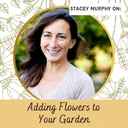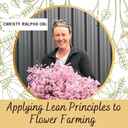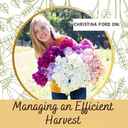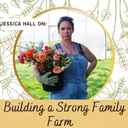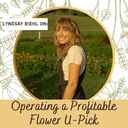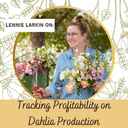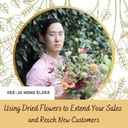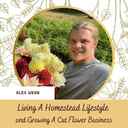Betsy Busche - Making Profitable Market Bouqets
49:11
Hello, everyone.
In this session of the Thriving Farmer Flower Summit, we'll be hearing from Betsy.
Although she lives on a small village lot Betty has been growing flowers commercially for the last 5 seasons in dormant gardens borrowed from friends and neighbors.
Her business spongettas garden is focused on market bouquets.
She sells at a farmer's market 3 stores in a twenty person CSA.
Betsy is gonna share with us about how to make profitable market bouquets.
Betsy's built her brand about having long lasting flowers.
In their talk today, she looks at choosing the best ingredients and crop planting so that she has the flour she needs throughout her bouquet season.
With several different bouquet sizes, Betsy relies a lot on recipes for quick assembly.
She's found some great ways to make money with stems for every length, and she'll share how to build recipes where the flowers last and you'll actually make a profit.
It.
My biggest takeaways here are the flowers that she avoids and why they don't make the cut when it comes to market bouquets.
Let's head on over to Betsy's talk and hear the exact flowers you need to make profitable bouquets.
Hi.
I'm Betsy Busch from Spongetta Garden in West Onefield, New York.
I am excited and passionate about making market bouquets.
These are my favorite way to sell flowers.
And today, I'm gonna tell you about how I make it work, what works for me and give you some ideas about what can work for you.
My business is Spendetta Starden, and I am a one person operation mostly.
I am a floating flower farm where I live in a small village lot, so people let me use their dormant gardens.
So I use 6 different gardens.
Or 6 different properties, including perennials.
Most of the labor is just me, and everything is scaled so that I can absolutely do everything each week by myself, but I do have some helpers including Noah here in the picture who sells at market with me.
I sell bouquets at the Saturday market in Utica, New York.
I sell the 3 stores.
I have a 20 member CSA.
We deliver on Thursdays, and I harvest 4 days to make bouquets on 2 days and they go out the door the day later.
Other outlets that I do, I do play with flowers classes where I have, like, people in and They have a flower bar, and they bring their own vase, and we make a bouquet.
Other outlets include play with flower classes where they bring a vase.
I set up a flower and they make a beautiful arrangements.
We have fill a vase where somebody brings a vase to my house.
I fill it for them, and I send it home with them, and then we do some special events.
I also supplement all of this with writing and presenting an education.
So we need to looking at this.
Understand where market vocates fit into the cut flower industry.
Americans spend over $8,000,000,000 in cut flowers a year.
Only 28% of that is grown here in the US, a lot of that is in California, a lot of that goes to Flores.
Most of the commons flowers that we think of are grown from cuttings that limits the number of varieties.
They're grown very quickly in tunnels.
A lot of these are raised that you will see in a grocery store bouquet are raised along the equator.
And something else to consider too is we're talking about all this is For locally grown flowers, we really can't hit those important flower holidays like Valentine's Day.
Or Easter.
Mother's Day is the one that most of us can do at least something for.
And we're also having fewer traditional florist these days, there's more dependent weddings especially around here.
I'm about 3 hours north of New York City, so there is a lot of destination weddings.
And then everyday flowers from grocery stores like these.
This is a $12 bouquet that we picked up this morning at our local hit effort.
Grocery store chains though don't allow us to just come in with our buckets.
Most of them at least are out here and drop off a few buckets of flowers each week at our local grocery store.
So we need to understand how we're gonna be competing with these and finding other ways to sell.
As we're looking at this, let's look at what is a good flower.
It is a variety that has a long straight stem.
It grows well where you live.
It holds once harvested in the base for 5 to 7 days.
It's gotta be cool.
It's gotta be pretty.
It has to have some sort of value And it's something that can sell too.
And the focus we're having is today is what we're talking about.
It's just gonna be field grown flowers, For me, my season is June through September.
So then let's talk about this in the bigger scheme as I wanna understand Mick's bill pay is in relation to the 2 other kind of areas that people sell flowers.
So, you know, events, mixed bouquets to grocery stores markets as we're gonna talk about and then wholesale mostly the forest or through a wholesaler.
And what's different in these different categories of what we grow may or may not cross categories or maybe they should cross categories so that we're not just depending on one incoming area.
So for weddings, We're gonna go across.
Wettings are focal flowers and greens.
That's a lot of what we're looking for, p n e's, roses, tuloupes, all those dahlias, and then the greens that support them.
And mix vocase, we're really looking at the disc around what the spikes, the fillers.
That's what we're making most of those Mexico k is from.
And then our wholesale for Flores, a lot of its focus, but it's also basics and it's also foliage.
As we're looking at the colors and how we're thinking, how we're doing it, the weddings are romantic, mixed bouquets are bright, And, honestly, for the flowers, it's the relationship you build with that florist because they're gonna tell you what they need and want.
And then as we're looking at weddings, it's a specific date.
Boom.
You need that for that Saturday.
For mixed bouquets, you need to have a very consistent supply so that you can make book pays 2 to 3 times a week.
And then wholesale, you do weekly deliveries.
So you have your bunches ready to go at a certain time.
In weddings, you can get away with using shorter stems.
For mixed bouquets, we want them to be at least 18 inches.
This is a 20 inch bouquet.
The wholesale for floor is 30 inches is about the standard.
So we're looking at the ability of using some of those shorter stems in the web work and saving the longer stems for florists.
Also, for weddings, you want them fully open or almost fully open for the event because they need to look beautiful for that event.
You're cutting them at that stage.
For mixed bouquets, we wanna cut at the earliest stage because we're trying to get as much of life out of that flower, and we'll talk about that more.
Wholesale early to mid stage depending on what they're trying to use.
And then kind of the last thing to consider is for a wedding.
We're cutting all week, and then we're holding them in the cooler, and we're working on them all week for that specific event.
On a Saturday for mixed bouquets.
We're cutting them.
We're making them bouquets.
We're getting them out of the door hopefully in 24 hours.
For florists, you're doing it you're cutting base on a consistent delivery schedule.
So it's a little bit different for all three, but this is how we see how they work together.
So market ok's.
These are a value added product.
They're like a self a kit.
We're not selling them the same way as we're not selling them as individuals necessarily.
We're selling them together in a value added product.
So we need to think about them in that sense of how we choose our flowers, how we choose our ingredients, basically, and then how we price it.
And we have the issue of it not being shelf stable.
So we need 2 crop plants.
So we have a consistent supply through the season.
My season is July 1st through the end of September for my CSAs and others, I need to have enough flowers to make it through that whole season.
In marketable case, we're using more common flowers.
We're using bright and wild fluff colors together that just kinda work together as you can see in the picture, and we're not necessarily using all the fancy flowers.
We're using the ones that we can grow quickly and have a lot of color from and be able to create the aesthetic that we want.
As I said earlier, we're gonna cut at an earlier stage so it lasts longer.
So what we need to consider is it can my expiration date on my bouquets at the farm stands and stuff is 3 days.
So it can set up to 3 days in holding solution, but I need to make sure that after that 3 days, it goes home with somebody and it lasts for at least 5.
So one of the ways I've built my reputation is on long lasting flowers.
So that stage of harvest is super important because people rely on me for oh, it lasted a week.
Oh, I'm not gonna get any of this week because they're still looking good.
Which is the worst thing I always hear.
So and then there is added labor to making the bouquets We can simplify that down by making things really quick, using an assembly line, having our packaging ready, all of that.
And speaking of packaging, we really for two reasons, I picked this picture because it's my buckets going out the door.
A later market 1 Saturday morning, and all of those bouquets are in their own white sleeve That sleeve is we'll talk about that more, but that sleeve is sticker.
My information is on it.
It looks clean.
It looks good.
And that's what people expect for me.
The biggest thing on that is when I go to market, I want my bucket it's ready to go.
I pack everything as it's going to be displayed so I can just lift it out of my car, put it up on the benches, and we're ready to go.
One more thing on that is really flowers at this level when we're talking about a 10, $12, $20 bouquet, these are refer recession proof.
People might not spend a $100 on an arrangement for someone, but they would gladly grab a quick bouquet.
If ours are more available locally and they're not going for imported flowers, then we are catching that market.
So we need to figure out where we can sell these and how we can sell them so that we're the ones that people think of when they think of grabbing something to give as a gift.
Okay.
So I just wanna talk about bouquet seasons because you can actually go from early bulbs all the way through into mom season in the fall.
If you have things like tunnels and, you know, have it all planned out, a greenhouse working it out, I am just gonna look today and talk about the vocational in June, July through September.
And this year, it went into October for me, and I'm very happy about that.
And this is what we kinda rely on because I think when we most farmers start with the tender perennials that are August September, but we can really extend our season by looking at hearty annuals or turn things over using perennials and biennials.
So those all fit in June.
So if you plan for me things that I planted in August, have been growing for a while.
These little tiny plants have been growing for a while.
They're happy plants now.
They're going to winter over.
Go dormant, and then they're gonna pop up, and I'm gonna have wonderful flowers to use in June.
June is the hardest one to keep it consistent because These are the flowers that aren't really cut and come again.
They're ones that are one shot, so you're trying to plan all of these together, but you can make it work.
It's possible to pull this off.
July then is spring planted, hearty annuals, and perennials, and you have lots of different options.
And then kind of late July, some of the tender annuals come in, and then you just have a fun mix of things.
And July August is a lot of succession planning.
And come and come again flowers.
So you pretty much have the same thing going until frost.
This year is the first year that I have successfully done 36 sessions of tender annuals so that I actually had flowers in to mid October.
And, you know, nice flowers, good flowers, not that I was grounding, but I had great flowers at that point still.
And it takes planning, and this is all about crop planning, which we're not gonna talk about as much today.
But it's a key point in being able to have all of this material available for you so you can get through the whole season.
Okay.
So one of the most important things I think, and this is a florist trick.
It is having a recipe that you have a plan I have certain ways that I do certain things at certain times of the year and it's really important to keep things consistent by knowing exactly what your stem count is.
It comes down to stem counts really important that you're not over stuffing or under stuffing, you know, short stems or trying to do crazy things.
And sometimes we end up when we don't have a plan we end up giving people too much.
And what that does to us is it really cuts into what we could actually be making as a profit on this.
And we need to not be ashamed about making our profit.
The other thing about a bouquet recipe is it's really quick assembly.
I throw everything we'll talk about that more.
For everything on the table in categories, and I walk through and I pick them up, I put them together, and I have a plan.
I do everything in threes.
I have things how they work.
And everything that I can do it.
The other thing about having a recipe is when we're talking about crop planting, that's how we know what we need, and we can do that math to figure out, okay, this is gonna bloom in a certain time.
So right now, I tripled my purple sensation allium.
So I have something right at the beginning of June as a fun kind of fokule flower.
I didn't have enough last year, so I needed another 100, and that was perfect.
The other thing is we don't wanna compete with our florist prices.
If we're underselling our bouquets, our florists are not going to sell by flowers from us for a higher rate.
Okay.
So my actually, we change the price on this.
My larger bouquet, we call this vendetta bouquet.
Is $20, and we generally put 18 to 24 stems, and it depends on what we have.
Some things are fuller with the tender annuals like in August, things are bigger, especially those big zingias take up so much space that you don't need as many other flowers.
And they're a cheap flower.
So it's great.
It's perfect.
The way I do it, there's a ton of videos out there that you can get ideas of how people are putting together what I do is I build a center of however many stems in the case of these.
I did it with c holly.
I will often use branching cosmos, and I cut these so that the first one is just emerging And then as they're in the bouquet, they keep emerging.
So that's a good one because it takes up a lot of space.
It gives you some whimsical feeling about it.
There's buds.
There's flowers.
They keep opening.
Some are spent.
They can cut off and keep going.
So those are my 2 favorite centers to use.
And then I use 3 spikes.
So we have something sticking up and being interesting.
And then I can do 6 to 9 round things depending on what I have.
So that could be anything from, like, Econesia, Daisy Lake Flowers, to therapist, which is more solid or fever, few.
And those kinda work around and add masks to your bokeh because you need it to be wide.
You need it to fill up that sleeve.
And then Sometimes I use a focal flower.
I don't use a focal flower in my $12 bouquet because when we talk about the math of it, It doesn't work.
It's too much.
So those are only in the 18 to $20 bouquets or even my CSA bouquets, which are worth 25.
And then the last thing that I do is I use pillars around the side as a cuff that adds some interest to it and kind of holds it all together.
Okay.
Now I'll talk about the categories, and I'll explain what I mean by center, which I already did with the cosmos.
Those are blinking They take up the space.
They add interest.
And then the spikes.
Examples of those are snapdragon or Amarin, the rounds, would be the days years in you, and then a cuff holds it together and a perfect one to use as status.
Focals are the special flowers that add value.
They enter size and a point of interest, actually.
And it could be my 2 favorites are Lily Dahlias, are probably the easiest ones to use.
So here's an important thing to consider.
When we talk about I'm not overstepping these vocs, competing with flowers from the grocery store.
We need to talk about how much something is worth.
What the cost of it actually is.
Even though we're growing it, there is still a value to it.
And then we need to consider that value when we are setting the price.
So I just took the sheet from my wholesaler, and I picked out 3 crops that are very basic ones that we would use in mixed bouquets.
So that you can see what the value actually is of them.
So they depend on size, and that's based on stem length, but that also shorter stem stem tend to have smaller flowers It depends on where they're coming from, how many they're requiring you to buy from the wholesaler, so it could be as many as 15 bunches.
And, you know, what the quality is.
So for Bells of Ireland, they could be 70 centimeters long.
Which I think is 27 inches about there.
So that's a pretty cheap one at 7.50 or it can go up to $11.
And so when we're talking about this, so that's a $0.75 stamp.
Blutiform, same sort of range goes from $8 up to over 13, dianthus, same kind of thing.
We need to consider this as if we're using 3 of each pair of okay that's basically 2.50 each.
1, we add this together.
That's $7 worth of flowers.
That's only 9 out of the 18 to 24 stems that were retailing for $18 or $20.
And as you're thinking about that, so we need to get those flowers in there for using a focal flower, it's probably $2 a stem.
And the things that are most expensive are the fipples and then the spikes.
Those are the really kind of expensive ones that we're working with.
And we have not included packaging, labor, marketing, sales tax, or if you're selling these wholesale, the marking them up.
Okay.
Now let's talk about which flowers we're going to use.
And this is what we need to think about is the flowers that we're choosing need to be easy to grow.
They need to be cheap to grow.
They need to grow fast.
They should be upward facing so that when they're in this sleeve, we can actually see them.
And that's a pretty important thing for bokeh is that our reps.
Something need to be easy to work with.
We don't have to use the florist quality ones on these.
So if we have smaller bells of Ireland, we should be putting those into our Mitzville pays.
If we have single stock, It's a great thing for mixed bouquets.
It's absolutely perfect.
They're still beautiful, but they're not necessarily something like the florists want.
You need to consider the minimum style length, as I said, at least 18 inches.
And then there's a really important concept that doesn't get talked about People are buying these.
Noah picked this up at the grocery store this morning on his way here.
And if Sam's are there, People are buying me is bringing them home.
You need to make sure that you are using flowers that will rehydrate again.
When I first started, I was so excited to use things like 9bark or hydrangea and bouquets, but then they weren't lasting for people because they would use our easy ones to rehydrate.
And then once again, they need to last at least 5 days and our customers' possession.
They need to be able to enjoy these how many of us at Farmers Market have people come up to us and say, I don't buy flowers because they just die.
Yeah.
It's a bingo game at our farmers market.
So have those for everybody.
It's really crazy, but the thing is if we work really hard to do everything right to make it work, that's gonna be fine.
Okay.
Upward facing, let me just define what this is.
Here, I have a couple last dahlias that are gonna help me out with this.
The difference is something that's upward facing like a sunflower That is pro Horizon, and there are a whole bunch of them coming out have been coming out in the last few years that are great.
Horizon is my favorite.
But the difference is in that sleeve, it's sticking up so you can actually see it opposed to a sungold.
I believe that one is And that one is side facing like this, so it's fine.
It's great in our arrangement, but it doesn't look as good in the sleep.
So here is an example of how that is with the dahlia.
Here is a forward facing one.
Here is an upward facing one.
This would be a lot easier to use in a bokey, then this one would be jammed in against the packaging, against the sleeve, and it would just look awkward as they're buying it.
Of course, it'll look good when I get home?
So this is what I have worked out in 5 years of what my bouquets are, what I'm using.
I started out with $5 bouquets that were mostly Xinyas, and I never sold them.
And then I started playing around, adding things, growing more things, and it took me a while to find my niche on that.
So then I had a $10 propane that was working, but I was realizing I was having more expenses than I was for flowers.
And it wasn't quite right.
So my 3rd year, I bumped it up to a $12 bouquet.
No focal flowers in it.
And that is the one that is my bread and butter, sells at the stores, sells at market.
That's what everyone's looking for.
And then we did the bigger ones was as we call the spongetta, and they're bigger.
And I'm giving you a different stem count on this one.
I'm sorry.
So 18 to 24 really is what we're doing.
They're fancier flowers and, you know, things in them.
And we have them at $20, and it wasn't working, especially Louisiana ones.
I cannot sell okay as well as the campus, and they never look special enough at that $20.
We dropped it to 18, and boom they sold out.
So those are my 2 main ones.
And then there was a week in July a few years ago when I did my CSA bill pay that I had nothing to send to the stores.
Everything was super short at that point.
So I just I had to show up with something So I threw together these bouquets with 8 to 10 shorter stems.
They have to be at least 12 to 14 inches.
And we call it the small because we're not creative in our names.
And priced it at $8 and they sold out, and they are a really popular one too.
Then at the end of the day, and I have to say, when I am harvesting, I clear field, I clear all the fields, I bring everything in, and then we go into the okay making Natasha, and I start with the big ones, and I work my way down, and I use every single stem that I can use.
The last thing that we do when we're done is take the random stems.
We put them together about 6 stems.
We wrap them in.
A doily that makes them even more special and sell them for $4.
And, you know, if you sell $12, $4 Vopay is a market you've got yourself another $48.
So it's really worth it to make sure that you use everything and figure out a way to do it.
Anything that's remaining still goes out the door.
It can be bunches.
Sometimes they do make your own at market, or I will whatever's left I will make an arrangement that will be, like, a just to get people's attention type of thing, that I will price on half the time myself.
So those are good chill.
Okay.
In marketing, there is this concept of friction.
What is stopping your customer from buying from you?
And we need to talk about what matters and what doesn't matter with these next vocays because we're thinking about Well, why are they gonna walk past me and go to the person who is selling a pot of 3 overload sunflowers and dirt because they think that's a better value.
Whereas my sunflowers were harvested at their great time so that they are going to last longer for them.
So people will buy what they value.
If something is not, selling something needs to change, and we're gonna talk about how to change that in a little bit.
But we need to think of it in those terms of if it's not selling, we need to add value to it.
Focal flowers do add value to some people, but I have found I don't even need to do that.
If you look at the bucket of this is a bucket of, I think, 4 or 5, it looks like, 5 bouquets headed to market.
These are just a simple chalk dollar ones.
People just grab these and went and absolutely love them.
They were beautiful.
And they were worth $12 to them.
So if you're adding value with focal flowers, you need to increase your price.
The other thing is filler really does matter, and it really it adds texture.
It adds birth to it.
It makes it a little bit adds masks to it, makes it a little bit bigger, and people value that more.
Also, Sage and Harvest, as I said, is incredibly important.
Some people will only buy full items, you know, full flowers, okay is with full flowers.
I've trained my customers to pick out these flowers that are not necessarily fully developed because they know they're going to open at home, and they have learned to value that.
Design is important.
Your focus have to be great.
And that's something, you know, some people have an inherent ability to see what works well together.
Some people have to work a little bit harder So design is where your bouquet recipe is super important.
But if you kinda have rules in your head of how you're gonna do it, it's gonna come out better, more beautiful, and consistent.
Also, seasonality of color, this was actually one that I did in September.
And sometimes in the fall, I cannot sell bright colors like this.
It worked this time.
Other times, people will be like, oh, that's too spring.
I'm not gonna buy that.
Or in June, they're not gonna buy something that's too natural that looks too fall.
So we need to keep those in mind.
I also have rules for colors, certain things I put together, certain things I don't.
I am not a big fan of yellow flowers or red flowers, and I certainly don't like them together because I just don't read, write, and sell low.
Okay.
So if they don't sell at first, you need to play around.
That includes lowering the price like I did for $2 for the mayor of Okay.
Adding steps, adding filler, making them fuller, not necessarily adding something expensive to it.
It might just be adding grasses to it, so it twinkles a little bit and has some more tax sure, and that might make a big difference.
And then the idea is also when I talked about the making myself, creating a new stem count as at a different price.
And, honestly, these are 3 things that you're always gonna keep playing with until you figure out who your customer is.
And your customers are gonna start reacting to what is working.
And that's your best feedback ever.
Okay.
So how to act make the market vocational.
There's lots of videos out here, so I'm just gonna kinda talk you through it.
I'm not necessarily gonna demo it.
Quality control happens at harvest.
This is super important.
I had a high schooler helping me.
We had really bad Japanese beetle pressure.
I'm assuming as a share of, like, worst that I've ever had before, like, of the 20 in the field I could take too.
And I had my fifteen year old helper harvesting and I told her, you know, just take the good ones and we'll go back I'll go back and deal with them later.
So when I am making my bouquets, I never even looked at those Xyngos because I thought she was taking care of quality control.
And and her hedge was like, well, let me grab as many and then Betsy will take what she wants.
And, yeah, we totally miscommunicated that day.
It was one of those days that I was making bouquets 9 o'clock at night for the market the next morning because of the weather.
And I did all these in the speed bouquet technique.
I got them all put together.
I'm putting them in their buckets, and I realized that I have all these nasty bad zenias because she was trying to help me.
And, you know what?
When you're making bouquets, you're not looking at your flowers.
So you need to make sure that you're picking them out as you're putting them into the bucket.
During harvest, everything's good.
The other thing is always stripping the stems in the field.
You will have a sense of how much you wanna leave on stamp performance in the actual bouquet, how many leaves you leave, whatever your rule is on that, stay consistent with it, when you harvest, put them in the buckets, get them out of the sun, let them sit for at least 2 hours.
I try to do overnight when I can.
This allows you to just pull your flowers out of your buckets, put them on the table, put them in your categories, and you can work along because it's it takes three times longer to make bouquets out of buckets than it does when they're laying flat.
Certain flowers, I don't lay out.
I don't usually lay out sunflowers or zenas because they get crushed.
And then with zenas, I really wanna see what my colors are.
Some of the farms doing less a lot of the videos that you're gonna see are farms that are making, like, one bouquet over and over and over again using the same flowers.
Those are also small like me.
Don't really have that option to do that.
So what we're doing, what I'm doing is things in the categories.
I know what my colors are.
I know how I'm working.
And I actually actually, instead of making them all the same, I make buckets that go together.
So, like, one bucket usually, these are my categories as one bucket is modern.
One bucket is natural, and one bucket is romantic.
And those are usually for me, those bouquets are pretty much hit every lot.
Hit all my customers on what they want, but my customers love to come to the market and pick it out.
They wanna find that perfect okay that they love this week.
So all of my bookings are different.
It looks like I put more work in job, but I'm actually going by categories, so I am doing that same thing.
Of doing them all the same, but they're not.
And it works for me.
So that's why the categories are super important.
That's why laying them out.
Working that way really works.
You know, kinda having a plan of knowing, okay, this is how many flowers I need for that bucket.
That's what I lay out.
So I gather using my recipe, and then I just do the whole where you hold them out and you twist.
Then we band them package them, and they go into the buckets of 4, 5, or 8 depending on which size it is.
And they are just ready to go out the door.
They go to the store that way or they go to market that way and they just get set up on my bench.
It's a lot easier.
The 1st year I was trying to do everything in Mason's hours and eliminating as much glass that you're handling if you're at a farmer's market is super important.
I think it's different if you're selling at a farm stand, and then you have them sitting in some sort of jar that is contained so you can see them.
That's great too.
Okay.
And one of the last things, Amit, is making sure you're taking a fresh cut.
You're putting them into the water.
They're in the buckets.
I use holding solution.
I think it's super important, especially when I am sending something to a store that it's gonna sit there for 3 days and want it to have the best chance of being fabulous by the time the person purchases it.
We wanna guarantee that and that really does help.
Especially on, you know, a 90 degree day.
They're sitting someplace that is not air conditioned.
Those stems can really get mass speak quickly.
So you want to get to the best advantage on that and use the products that best help it.
Packaging is super important for two reasons.
First is it protects the flowers.
So as you're putting them in the bucket, people are pulling them out of the bucket.
They're taking them home.
Nothing is getting bruised, nothing is getting banged around.
The other reason on that is your branding because that's where you put your contact information, whether it's your sticker or your stamp, That's how they get a hold of you.
I use my web page, and I use my phone number.
And those two work pretty well.
So commercial sleeves.
Right?
You can just order either come in plastic or in paper.
You can get the plastic ones printed.
The paper ones are great for stamping or with your sticker.
I actually like to use put your paper.
So this is an 18 square 18 inch square piece of butcher paper.
I fold it.
I wrap it up and around.
I put my sticker on it.
And the reason I use it, it's not as fast as having a sleeve when you're trying to do it.
My branding, I prefer to have the white.
The other reason I like to use it is these are pretty water repellent compared to just the craft paper, and we're dealing with open buckets So I have found it's more forgiving.
So I just had stickers made.
These just run through my friend's printer, and he does them for me.
Has my contact information, has my logo, and that's what you need.
And it looks great against the weight.
As I mentioned with the doilies, I do I put the posis in these.
And then I just use a clearer label that we put through our printer on these that have the contact information So I'm not spending as much money for that sticker, but I'm still getting it on there.
And there's lots of options for how we can do this cheaply or it gets more complicated.
If you're doing grocery stores, you need to have codes on them, so that's different.
So, you know, kind of figuring out what you wanna use, how you wanna use it, and what your options are.
First of all, these pictures are for my 2nd year.
And I was trying to sell off my porch with a bucket and a sign and a little pager, and no one in my community.
I had a few people, but didn't really go for it.
And then the bottom photo is our 3rd week at market ever, and that's my husband, and I had crafts, and I had a table of flowers with a mason jar with a jars.
And there's my bouquet stand.
And it really wasn't spectacular.
It took me it took me 3 years to find my comfy place.
Of what works for us, what's easy to set up, what colors work, how to get people's attention.
People actually look for me.
They know my spots, If I'm not there, one day I was shoved down and at one spot and some people were a little confused because they were headed right to me and I wasn't there.
Those are important things to kinda think about, but I just wanted to show that this is where I started.
We all have to start somewhere, so try it.
And then try something else, and then keep trying until you find your comfortable place with marketing.
So where to sell next vocase CSA shares.
So I have a bouquet subscription, and it's 10 or 5 weeks is how I do it.
Some people do it by season, so they'll do a spring, summer fall 1.
That way maybe through or 4 through those.
Mine are every week or every other week.
I have some people who I just will get in touch with him.
They'll let me know what days they want the bouquets.
I have a core group of people who are my bread and butter on this They love their bouquets.
They're so excited to have them every week.
They bought them into the fall extra ones into the fall even when we were done.
This is something that they love, they value, if they're happy thing.
And most of them are giving it to themselves, which is to me, like the self care is really what I have had to market the CSA too.
Both gifts, people still do it for gifts, but there's also a lot of people doing for themselves, and it's you need to look at your demographic of who that is.
And it's for me, it's women who have their own income who are able to spend money on themselves and choose to spend money on themselves.
So okay.
So farmers market.
I only sell it 1.
I am in the O nine accounting public market at the Utica train station, so it's an urban market.
I have been there for 4 years now.
It's been an absolute great place for me to be able to grow and find my place.
During market this year, we have a classroom.
I was absolute or I was actually able to host play with flower classes during market so people could come to market, play with the flowers, and then go shop at market, It was a great job for me.
It was a great job for our market.
So farm Sam, I don't have a place that I can sell on the side of the road.
But they're popping up everywhere, and it's a great market or great option for people.
You have to consider that you're protecting the flowers, that you're in a good place they can find you and that you're making payments easy.
I'm just gonna do the plug for Venmo and all the difference in the world as far as just keeping easy.
And then selling the stores, and then we have to think about is it gonna be consignment or wholesale?
I have tried different firm stands.
Other people's firm stands.
I have tried some other stores.
And for me, I sell to the or I consign through the stores that are a little bit bigger, heavier traffic, one's a greenhouse, one's a farm stand in a suburb, you know, that kind of thing.
I sell to the ones that I know I can sell at least 2 buckets a week from trying to get it higher.
So we have minimums for buckets.
There was one farm stand that just wanted to buy 2 bouquets a week, wholesale, and it wasn't worth driving there.
And they weren't really selling because no one ever buys that last.
Okay?
So I have minimums by the bucket.
I ask people to purchase as buckets, full buckets.
So for the everyday bouquets, that's 5 bouquets, and then we can do multiples from there.
I don't charge delivery to those 3 main stores.
I will to others.
I'm going out of my way for something, and it's only gonna be a $25 sale, and we need to put that extra $10 in there so that I am paying my driver to go there and we're not making any money.
So that's the thing I've been playing around with, and I still don't have that totally down.
But something we need to consider because it's a huge expense.
Driving half an hour or an hour to drop something off is a huge expense of labor, of mileage, of gas, all of that.
And then the last thing that's super important is making sure that whoever you're selling to with these respects an expiration date.
They should not be in a store for more than 3 days.
They need to be donated or tossed, composted, after 3 days, and that is the risk we all have to take on that.
And sometimes with wholesale, you're doing the wholesale price, and then there's a buyback for things that don't sell.
So you need to take that in consideration.
I need to take that in consideration for when I'm I'm pricing.
If I'm only doing an everyday of okay, I'm selling it for $6 and then if they don't sell it, they want, you know, $3 back, then I I just keep losing money, and that is an issue.
Okay.
So let's get into some things.
We talked about what to use, but I really wanna kind of focus this so that you're kind of excluding a bunch of flowers that you're not gonna use for this, and then you can do ones that you can use.
So things that don't really grow well in the field, they'll phineon because of wind, and the type of delphineon.
If you do the column, tall, beautiful column, like the Pacific Giant ones, those don't really fit into a bouquet either.
So I do the Veladonna style ones that are more open and blue, and they do work in a okay, but they have to be grown someplace where they're not gonna be blown over.
Bills of Ireland, I have just had the worst time this year, they all molded.
Sometimes it's too hot.
They don't germinate well.
I wasn't able to winter them over.
So I have really struggled with those.
So they're out of my program actually.
Cost per stem.
You know, p and e's, eucalyptus are 2 great examples of things that are expensive.
So those should be saved for times where you're going to actually get that money back from them, so that use them for arrangements on the florists.
Things are not prolific.
I've given up on the carnation and Crysvita both because the amount of ground that they take off for what they produce just as a worth it.
And then disease, pet pressure, cactus syringes have been really hard to get work, Another one is light colored snapdragons just showing trips or other issues, and they don't hold up as well.
Height or things that are short like Dusty Miller, vernaculars, like some copies.
Those are all great examples.
They have great uses if you are doing arrangements or if they're doing little bouquets.
But they're not for those everyday bouquets, they're just not gonna make it.
Things that are in the wrong shape, meaning you know, the cascading amaran.
Coxcomb just is too big or hydrangea.
They just Big hydrangea.
I just have never figured out how to fit one of those into a bouquet.
Things that shatter their colors, sunflowers are, you know, just They're fantastic and theory, and they just don't hold up.
Hydration issues, things that you're struggling with.
I already mentioned in Woody's how tough they are to use InfoCASE because you can't rehydrate them.
And then others that have, like, Indian summer, Rebekah, I love but it doesn't always rehydrate for the customer.
So that can be an issue.
And then things that are dangerous, monkshood sound amount are my 2 big ones.
Amongst it is just poisonous, and snow on the mountain has a sap that it lets off.
And you just You can use both of those in arrangements or other things, but you don't want them on something for people are touching the end of the stem.
Okay.
So here is something I have discovered is I have a couple combinations at weird times that work super well, and they've become not only go to is for me, but my people or my customers are looking for And one of them is doing Lamzier with the purple sensation allium.
They're both ready at the same time.
I put 3 helium in, I put 5 lamps here, and that's it.
And people love them.
They sell out and this is why I'm doing more purple sensation.
I am because it's just something I'm equal love.
And Lam's ear, if you just have a patch and let it go, and then I cut 70 last year.
And, you know, it was fine.
It was happy.
It's not even that big of an area.
So some people complain about lands here.
I think it's wonderful for this orism.
And as I said, they sell out every time.
The other one that works really, really well for me are cosmos and the dark red Amaran just putting bouquets and those 2 together and putting them out there people love, so they look great together.
Okay.
So the last thing to talk about is still, you know, what can you do for a straight bunch?
What can you sell at market or at a store or a farm stand when you have a lot of something, and you're just not quite sure what you're gonna do with it.
So they are like focal flowers.
You can always find you know, the sunflowers, lizzies, zenoes, dahlias, lilies, all of them just make beautiful bunches, people are happy to pay whatever you put on those, and you can get more money when it's those bunches.
So I sell more bunches of sunflowers.
I price them at $10, and then I do my stem count based on how much I think that particular sunflower is worse, so it could be 6 in a bunch.
It could be 10 in a bunch to if they're the little mini ones.
And if I just did them individually and set and I do this also, and I just say a dollar per each or If I do that, we sell less actually.
People love the bunches.
So just grab the bunches and go.
Well, also specialty short items.
The big one on here is sweet peas.
Little vases of sweet peas.
Everybody absolutely loves.
Other things that work like that are columbine and myjella, bunches of daffodils, bunches of tulips, of course, and buds.
I will sometimes do buds in a bunch instead of signals.
I do bouquets with buds.
And then how things are going.
And then things that are daisy, like, really do well in bunches, and that is the black eye too, ma'am.
It's a shasta daisy.
It's a Cia Kinesha.
And then anything that can be dried.
So status, cellulosia, Camparena, and marigolds are some of my really common ones that I will bunch up.
And then if they don't sell, I just bring them home and hang them.
So I have more dried flowers.
Although Betsy Busche lives on a small village lot, she has been growing flowers commercially for the last five seasons in dormant gardens borrowed from friends and neighbors. Her business, known as Spongetta's Garden, is focused on market bouquets sold at a farmers market, through 3 stores, and a 20 person CSA. She uses her background in art and photography to host design classes along with Play with Flowers, informal make an arrangement sessions. For the last two years, she has teamed up with Cornell Cooperative Extension of Delaware County for the love of all things flower.
In her presentation, you will learn:
- Some of Betsy's top recipes and the money math!
- What flowers you might want to avoid in mixed bouquets
- The bouquets that sell great for Betsy with just 2 flower varieties!
How to connect with Betsy: spongettasgarden@gmail.com













